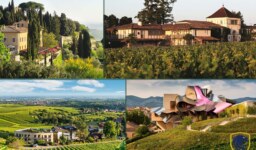Pilgrimages are a time-honored ritual that spans nations, faiths, and eras. Pilgrimage routes offer a unique blend of physical challenge, spiritual introspection, and cultural immersion. From the ancient trails of Europe to the sacred paths of Asia, epic pilgrimage routes have captivated the hearts and minds of travelers seeking something beyond the ordinary. In this article, we delve into the world of pilgrimage. And we are uncovering some of the most extraordinary and revered routes across the globe. Whether you seek enlightenment, personal growth, or simply a profound connection to history and spirituality, these epic pilgrimage routes hold the promise of transformation and adventure.
The Camino de Santiago
The pathway of St. James, usually referred to as the Camino de Santiago, is a well-known pilgrimage path in Spain. There is a network of paths that go to the cathedral at Santiago de Compostela, Galicia, northwest Spain, which houses the shrine of the apostle Saint James the Great. The Camino de Santiago has been traveled by pilgrims for centuries. Those pilgrims seek spiritual growth, reflection, and the experience of visiting the tomb of Saint James. It begins at the French hamlet of Saint-Jean-Pied-de-Port along the French Way, the primary Camino de Santiago route. And it stretches approximately 780 kilometers (500 miles) to Santiago de Compostela. Moreover, the journey takes pilgrims through diverse landscapes, charming villages, historic towns, and beautiful countryside.

The Camino de Santiago
Walking the Camino de Santiago offers a unique experience of cultural immersion, camaraderie, and personal growth. Also, along the way, pilgrims can enjoy the stunning scenery, interact with fellow walkers from all over the world. Furthermore, they can visit historical sites, churches, and monasteries. The Camino de Santiago is not simply a religious pilgrimage. But also it draws people from all walks of life, including hikers, nature lovers, and those looking for a meaningful and transforming experience.
Moreover, it is a well-marked route with accommodations, known as Albergues, available for pilgrims along the way.
Completing the Camino de Santiago is a personal achievement and many pilgrims receive a certificate, called the Compostela, upon reaching Santiago de Compostela. The city itself is a vibrant destination, with its beautiful cathedral, narrow streets, and bustling squares. Whether walking a portion or the entire Camino de Santiago, it is an unforgettable experience that combines physical challenge, spiritual reflection, and cultural exploration.
Kumano Kodo (Japan)
Kumano Kodo is a sacred pilgrimage route in Japan that leads to the Kumano Sanzan. Three shrines make up the group: Kumano Hongu Taisha, Kumano Hayatama Taisha, and Kumano Nachi Taisha. It is one of the most important pilgrimage routes in Japan and has been designated as a UNESCO World Heritage Site. The Kumano Kodo encompasses several trails that traverse the mountainous Kii Peninsula in the Wakayama Prefecture. The most well-known route is the Nakahechi Route, which historically served as the main approach to the Kumano Sanzan. Other routes include the Kohechi Route, Omine Okugake Route, and Iseji Route, each offering its own unique experiences and sights.

Kumano Kodo (Japan)
Walking the Kumano Kodo, pilgrims pass through dense forests, picturesque valleys, and serene rivers, immersing themselves in the natural beauty of the region. Along the way, they encounter sacred sites, ancient shrines, and tranquil temples that have attracted pilgrims for centuries. The Kumano Kodo is not just a religious pilgrimage. It also offers a chance for personal reflection, spiritual renewal, and an opportunity to connect with the rich cultural heritage of Japan. The journey is a physical challenge, as the trails can be steep and rugged in certain sections. So, it requires stamina and determination.
At the end of the pilgrimage, many pilgrims visit the Kumano Sanzan shrines. There they can offer prayers, seek blessings, and experience the sacred atmosphere of these revered sites. The Kumano Nachi Taisha, with its iconic Nachi Waterfall, is particularly awe-inspiring. Throughout the journey, pilgrims have access to accommodations such as minshuku (traditional Japanese guesthouses) and ryokan (traditional inns), where they can rest, enjoy local cuisine, and interact with the local community.
St. Olav’s Way (Norway)
St. Olav’s Way, also known as St. Olav’s Path or Pilgrimsleden, is a historic pilgrimage route in Norway. It spans from Oslo to the Nidaros Cathedral in Trondheim, a distance of around 640 kilometers (400 miles). St. Olav Haraldsson, the patron saint of Norway, was the personage who left behind this historic path. Beginning in the vibrant city of Oslo, pilgrims embark on a spiritual journey through diverse landscapes. The trail takes them through serene forests, charming villages, and picturesque countryside. Along the way, they encounter medieval churches, ancient ruins, and sacred sites associated with St. Olav’s life and legend.

St. Olav’s Way (Norway)
Transitioning from urban settings to tranquil nature, pilgrims experience a sense of peace and introspection as they traverse rolling hills, lush valleys, and meandering streams. The beauty of the Norwegian countryside provides a serene backdrop for contemplation and connection with nature. St. Olav’s Way is not only a physical endeavor but also a cultural and spiritual pilgrimage. People from various backgrounds and faiths undertake this journey seeking personal growth, inspiration, and a deeper understanding of Norway’s heritage.
The camaraderie among fellow pilgrims fosters a sense of unity and support. As travelers share stories and forge new friendships, a sense of community is formed along the trail. Arriving at the Nidaros Cathedral in Trondheim, pilgrims experience a profound sense of achievement and reverence. This grand cathedral, a masterpiece of Gothic architecture, stands as a symbol of centuries of pilgrimage traditions and the enduring legacy of St. Olav.
Via Francigena (Italy, France, Switzerland)
Via Francigena, also known as the “Frankish Route,” is an ancient pilgrimage trail that spans across Italy, France, and Switzerland. This historic route traces the path taken by medieval pilgrims traveling from Canterbury, England, to Rome, Italy. Beginning in Canterbury, the Via Francigena winds its way through the picturesque landscapes of England before crossing the English Channel into France. Pilgrims traverse charming French villages, vineyards, and rolling countryside as they make their way southward. Continuing into Switzerland, the trail showcases the breathtaking beauty of the Swiss Alps. Pilgrims pass through alpine meadows, serene valleys, and quaint Swiss towns, providing a scenic and tranquil experience along the route.

Via Francigena (Italy, France, Switzerland)
Entering Italy, the Via Francigena unveils the captivating landscapes of Tuscany, renowned for its rolling hills, vineyards, and medieval towns. The route passes through historical cities such as Siena and Lucca, offering pilgrims a chance to immerse themselves in Italian art, culture, and gastronomy. The journey concludes in the eternal city of Rome, where pilgrims can visit iconic sites such as St. Peter’s Basilica and the Vatican City. Arriving in Rome is a significant milestone, symbolizing the completion of the pilgrimage and providing a sense of spiritual fulfillment.
Walking the Via Francigena is a transformative experience that combines physical challenge, cultural exploration, and spiritual reflection. Pilgrims can encounter a rich tapestry of historical landmarks, religious sites, and natural beauty, all while connecting with the traditions and heritage of the countries along the route. The Via Francigena continues to attract modern-day pilgrims seeking an authentic pilgrimage experience. It offers a unique opportunity to follow in the footsteps of ancient travelers, discovering the diverse landscapes and rich cultural heritage of Italy, France, and Switzerland.
The Inca Trail to Machu Picchu (Peru)
The Inca Trail to Machu Picchu is a world-renowned pilgrimage route in Peru. This ancient trail winds through the Andes Mountains, offering breathtaking scenery, fascinating archaeological sites. Also, it constructs a deep connection to the Inca civilization. Starting at Kilometer 82, near the village of Ollantaytambo, the trail follows a path that was once used by the Incas. They used this trail to reach the majestic city of Machu Picchu. The journey covers approximately 43 kilometers (26 miles). Furthermore, it takes hikers through diverse landscapes, including high mountain passes, cloud forests, and lush valleys.

The Inca Trail to Machu Picchu (Peru)
Along the Inca Trail, pilgrims encounter impressive Inca ruins, such as Wiñay Wayna and Runkurakay, which provide insights into the ancient civilization’s architectural and engineering prowess. Arriving in the breathtaking Machu Picchu, also known as the “Lost City of the Incas,” perched among the mountains, is the pilgrimage’s high point. The trail is physically challenging, with steep ascents and descents, requiring stamina and endurance. Hikers must acclimate to the high altitude, making it essential to take breaks and stay hydrated along the way.
Permits are required to hike the Inca Trail, and there are limited spots available each day to preserve the integrity of the trail and protect the environment. It is recommended to book in advance to secure a spot. The Inca Trail to Machu Picchu offers not only a remarkable outdoor adventure. But also a spiritual journey through ancient history. It allows pilgrims to immerse themselves in the mystical ambiance of the Andean mountains. Moreover, it allows them to connect with nature, and appreciate the incredible achievements of the Inca civilization.




